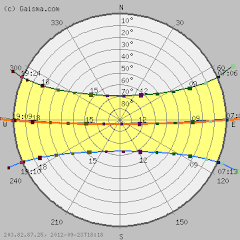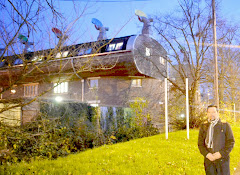
by Susie Kim-Carberry
http://greenbuildingelements.com/2011/01/13/green-building-101-using-bioclimatic-design-to-build-a-passive-sustainable-dwelling/
Source: The American Institute of Architect, Eco House by Sergi Costa Duran, Center for Renewable Energy Sources and Savings
Photo Source: Flickr by CCL-Pablosanz; Firefly Publishing
January 13, 2011 in Energy, Energy Efficiency, Green Building, Green Construction, Green Design, Green Technology
A Bioclimatic Design building, Ecobulevar Vallecas in Madrid Spain
Building a greener dwelling isn’t some lofty idea but practical solutions we all must make to build a more sustainable future. As we started with consideration of space in Green Building 101- Week 1; now we look at the environment around us as we build our sustainable dwelling. By building in harmony with the natural environment and cooperating instead of fighting with the regional climate; Green Building takes a passive approach which requires less energy to run once the building is erected.
The Center for Renewable Energy Sources and Savings (CRES) states, ”The reduction of energy consumption in buildings can be achieved by simple methods and techniques, using a appropriate building design (bioclimatic architecture)”. Bioclimatic design is utilized during the design phase of a home or building.

Bioclimatic design help conserve resources while facilitating the use of the local climate around a dwelling to construct a green home or building that is passively sustainable. Some of the concepts of Bioclimatic Designs are, “Site and climatic analysis, design strategies that reduce or eliminate the need for non-renewable energy resources and how these strategies specifically affected placement, orientation, and shading of the building.” according to The American Institute of Architects,
“Eco House-Practical Ideas for a Greener, Healthier Dwelling”, by Sergi Costa Duran, lists 10 fundamental Bioclimatic Design concepts:
1. Main façade face south which provides shade in the summer and sunlight during the winter time. The positioning of lower edges of roof are dependent upon the latitude of the building.
2. Home should be close to deciduous trees (trees that shed their leaves annually) which will provide shade in the summer.
3. Solid walls and materials allow greater “thermal inertia”-the ability of material to store heat and energy- which builds more heat to release steadily. A heat recovery ventilation system can be installed which includes: solar thermal panels, insulation, triple-glazed low-E windows, supply air, extract air, heat recovery ventilation system and gound heat exchanger.
4. Large glass should be installed in south side of house to allow solar energy to collect.
5. A thermo-wind self suction hood should be installed in chimneys which expels fumes and excessive heat. It also prevents them being sucked back in to the home.
6. Abundant use of skylight and strategically placing them according to sun positions for best natural lighting. Skylights can light up hallways, bathrooms, attics and other rooms. Using hinged skylights allow the windows to be adjusted according to season. “Since they fold up and can be adjusted, when opened in summer they get rid of the hot air and create cross-ventilation,” Duran said.
7. The use of natural insulation and breathable, waterproof materials for the roof.
8. Using local resources for building materials to cut down on transportation carbon energy.
9. Radioactive materials should emit no more than 180 mrads annually; Radon gas is a well known lung cancer causing radioactive chemical.
10. Home’s electricity must meet a requirement of volts per meter. Synthetic and ferromagnetic materials should not be overused as they create electrostatic charges.
Other features such as rainwater collection, photovoltaic solar installaction (solar panels), wind turbine, underfloor heating such as ceramic and mortar, geothermal installation and roof garden can also be utilized for Bioclimatic design.

A Bioclimatic Design building, Ecobulevar Vallecas in Madrid Spain
Although, the Bioclimatic design primarily focuses on Environmental sustainability; it also takes into consideration the inhabitant’s comforts as well. According to CRES, Bioclimatic Design includes “Adjustment of environmental conditions in the interiors of buildings so that their inhabitants find them comfortable and pleasant (i.e. increasing the air movement inside spaces, heat storage, or cool storage in walls).” Mixing nature with creature comforts is the perfect balance of well thought out and intuitive design.

With some logistical organization and well thought out design process, building a green home doesn’t have to sacrifice comforts of a home. Using the resources around us and working with Mother Nature, we can build a perfect home that harmonizes with its natural environment. Bioclimatic design makes most of the local climate including the sun, the wind and rain to design a comfortable dwelling that works passively to heat and cool the indoor space and even light the building.
Editor’s Note: Green Building Elements is launching Green Building 101 Series which will be posted every Wednesday. Take this challenge with us as we learn how to build sustainably from the ground up.




